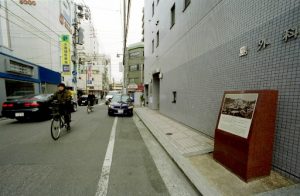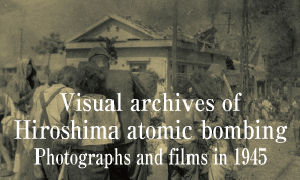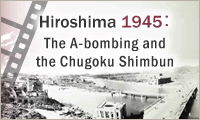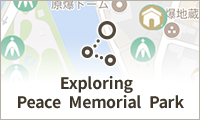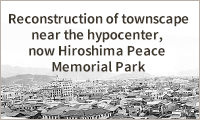A-bomb exploded 580 meters in air, leaving 257 confirmed dead in former Saiku-machi, with 304 area people, including those on commute or mobilized for work, perishing
Feb. 21, 2000
When the atomic bomb was dropped on Hiroshima on August 6, 1945, residents of the city’s Saiku-machi (present-day Ote-machi 1-chome, in the city’s Naka Ward), located at the hypocenter, as well as employees and mobilized students at the Hiroshima Post Office in the same area, died in the bombing. The Chugoku Shimbun newspaper published a report on the deaths of those people in the bombing, with help from bereaved family members, on February 20, 2000. A total of 41 residents, as well as 216 employees and mobilized students, totaling 257 people who are thought to have been at the hypocenter, were confirmed to have died at the instant of the detonation, which took place around 580 meters in the sky above the city. Of that number, 255 people, or 99 percent of the total, died on the day of the atomic bombing, while the remaining two died three days later. Including those who experienced the atomic bombing at building-demolition work sites, at the sites of relocation, or on their way to work, a total of 304 people (72 of whom were residents of the area) had died by the end of September, with the remains of 261 people, or 86 percent, never having been found.
The area of Saiku-machi, located next to the A-bomb Dome, now makes up one part of the center of the city of 1.12 million people. Because the bombing completely destroyed the area, ties among bereaved families were also severed. Using information gathered during a survey to recreate the area conducted three years ago together with former residents of Sarugaku-cho, an area situated to the north of Saiku-machi, as well as information on the whereabouts of bereaved families provided by Toshiaki Tanaka, 82, who once ran a grocery store in Saiku-machi and now lives in Hiroshima’s Higashi Ward, the Chugoku Shimbun conducted a search of households related to the area one at a time.
The survey showed that on August 6, 64 people in 19 households were living in the area, 41 of whom died in Saiku-machi from the atomic bombing. Another 10 people were found to have experienced the bombing and died at places they had traveled outside their homes. Including households that had been demolished as a result of forced building-demolition work that began in the area in May 1945, as well as people that had evacuated to other places, there was once a total of 37 households in Saiku-machi. Including people who had returned home to Saiku-machi at the time for personal or business reasons and those who had died in the bombing at their place of relocation, the death toll among Saiku-machi residents totaled 72 people, among whom the remains of 45 have never been recovered.
In addition, patients who had been hospitalized at Shima Hospital (present-day Shima Surgery Clinic), located at the hypocenter, were also in Saiku-machi at the moment the atomic bomb was dropped.
As for the Hiroshima Post Office, the Chugoku Shimbun carried out a search for bereaved family members using information in the possession of former colleagues or stored at related organizations, based on the names of 288 people (222 employees, 64 mobilized students, and two accompanying teachers) engraved on a monument at Tamon-in Temple in the Hijiyama-cho district in Hiroshima’s Minami Ward.
Those whose circumstances at death in the atomic bombing were known totaled 173 employees, 41 mobilized fourth-year students from Gion Girls High School (present-day Gion High School), and nine second-year students from the advanced program at Honkawa National School (now Honkawa Elementary School), all of whose names are inscribed on the monument. In addition, one student from Gion Girls High School and eight children of employees who had been in the Post Office employees’ nursery were newly confirmed to have been among the dead, bringing the total to 232 people. Meanwhile, three students who were listed as deceased on the monument were later found to be alive and well.
A total of 216 people were believed to have been in the Post Office building at the time of the atomic bombing, all of whom, except for one person who died three days after reaching home, died in the bombing. Another 16 people experienced the bombing and died on their way to work or at other workplaces. The remains of 216 people among them have never been found.
As if revealing the ferocity of the bombing directly beneath the detonation, the names of the A-bomb victims and the locations where they experienced the bombing confirmed by their bereaved families do not always match those obtained through the surveys that form the basis of the city’s register for the A-bomb victims or those contained in documents involving the Hiroshima Post Office and, in some cases, such details were never recorded. With that, many aspects of the overall damage caused by the atomic bombing remain unclear.
(Originally published on February 21, 2000)
The area of Saiku-machi, located next to the A-bomb Dome, now makes up one part of the center of the city of 1.12 million people. Because the bombing completely destroyed the area, ties among bereaved families were also severed. Using information gathered during a survey to recreate the area conducted three years ago together with former residents of Sarugaku-cho, an area situated to the north of Saiku-machi, as well as information on the whereabouts of bereaved families provided by Toshiaki Tanaka, 82, who once ran a grocery store in Saiku-machi and now lives in Hiroshima’s Higashi Ward, the Chugoku Shimbun conducted a search of households related to the area one at a time.
The survey showed that on August 6, 64 people in 19 households were living in the area, 41 of whom died in Saiku-machi from the atomic bombing. Another 10 people were found to have experienced the bombing and died at places they had traveled outside their homes. Including households that had been demolished as a result of forced building-demolition work that began in the area in May 1945, as well as people that had evacuated to other places, there was once a total of 37 households in Saiku-machi. Including people who had returned home to Saiku-machi at the time for personal or business reasons and those who had died in the bombing at their place of relocation, the death toll among Saiku-machi residents totaled 72 people, among whom the remains of 45 have never been recovered.
In addition, patients who had been hospitalized at Shima Hospital (present-day Shima Surgery Clinic), located at the hypocenter, were also in Saiku-machi at the moment the atomic bomb was dropped.
As for the Hiroshima Post Office, the Chugoku Shimbun carried out a search for bereaved family members using information in the possession of former colleagues or stored at related organizations, based on the names of 288 people (222 employees, 64 mobilized students, and two accompanying teachers) engraved on a monument at Tamon-in Temple in the Hijiyama-cho district in Hiroshima’s Minami Ward.
Those whose circumstances at death in the atomic bombing were known totaled 173 employees, 41 mobilized fourth-year students from Gion Girls High School (present-day Gion High School), and nine second-year students from the advanced program at Honkawa National School (now Honkawa Elementary School), all of whose names are inscribed on the monument. In addition, one student from Gion Girls High School and eight children of employees who had been in the Post Office employees’ nursery were newly confirmed to have been among the dead, bringing the total to 232 people. Meanwhile, three students who were listed as deceased on the monument were later found to be alive and well.
A total of 216 people were believed to have been in the Post Office building at the time of the atomic bombing, all of whom, except for one person who died three days after reaching home, died in the bombing. Another 16 people experienced the bombing and died on their way to work or at other workplaces. The remains of 216 people among them have never been found.
As if revealing the ferocity of the bombing directly beneath the detonation, the names of the A-bomb victims and the locations where they experienced the bombing confirmed by their bereaved families do not always match those obtained through the surveys that form the basis of the city’s register for the A-bomb victims or those contained in documents involving the Hiroshima Post Office and, in some cases, such details were never recorded. With that, many aspects of the overall damage caused by the atomic bombing remain unclear.
(Originally published on February 21, 2000)

